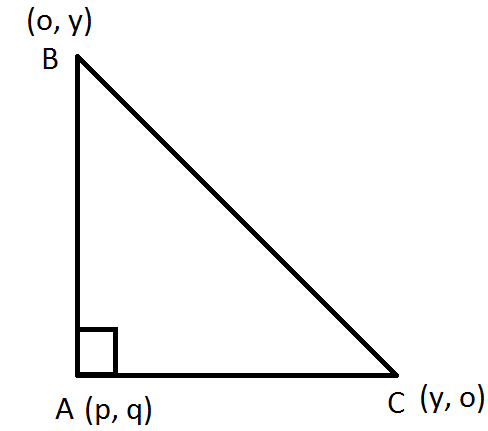
Answer
469.5k+ views
Hint: a locus (Latin word for "place", "location") is a set of all points (commonly, a line, line segment a curve, or a surface) whose location satisfies or is determined by one or more specified conditions. In other words, the set of points that satisfy some property is often called the locus of a point satisfying this property.
The locus of a point P is such that it is equidistant from two given points. A and B i.e. PA=PB. The locus of a point at fixed distance d, from point P, is a circle with given point P as its center and d as its radius. Here in this question, we can use the distance formula for two given points.
Distance formula = \[\sqrt {{{(x_2 - x_1)}^2} + {{(y_2 - y_1)}^2}} \]
Complete step by step answer:

Let the point be \[(p,q)\]
\[B{C^2} = A{B^2} + A{C^2}\](By Pythagoras theorem)
\[{(4 - 0)^2} + {(0 - 4)^2} = {(p - 0)^2} + {(q - 4)^2} + {(p - 4)^2} + {(q - 0)^2}\]
\[16 + 16 = {p^2} + {q^2} + 16 - 8q + {p^2} + 16 - 8p + {q^2}\]
\[32 = 2({p^2} + {q^2} - 4p - 4q) + 32\]
Or \[{p^2} + {q^2} - 4p - 4q = 0\]
Replacing \[p \to x\]and \[q \to y\]
\[{x^2} + {y^2} - 4x - 4y = 0\] is the locus of the equation.
Note: we can also find this finding slope of two lines AB as \[m_1 = \dfrac{{y_2 - y_1}}{{x_2 - x_1}}\], and AC as \[m_2 = \dfrac{{y_2 - y_1}}{{x_2 - x_1}}\]
And for perpendicular lines\[{m_1}{m_2} = - 1\]
We get the required locus of the third vertex.
The locus of a point P is such that it is equidistant from two given points. A and B i.e. PA=PB. The locus of a point at fixed distance d, from point P, is a circle with given point P as its center and d as its radius. Here in this question, we can use the distance formula for two given points.
Distance formula = \[\sqrt {{{(x_2 - x_1)}^2} + {{(y_2 - y_1)}^2}} \]
Complete step by step answer:

Let the point be \[(p,q)\]
\[B{C^2} = A{B^2} + A{C^2}\](By Pythagoras theorem)
\[{(4 - 0)^2} + {(0 - 4)^2} = {(p - 0)^2} + {(q - 4)^2} + {(p - 4)^2} + {(q - 0)^2}\]
\[16 + 16 = {p^2} + {q^2} + 16 - 8q + {p^2} + 16 - 8p + {q^2}\]
\[32 = 2({p^2} + {q^2} - 4p - 4q) + 32\]
Or \[{p^2} + {q^2} - 4p - 4q = 0\]
Replacing \[p \to x\]and \[q \to y\]
\[{x^2} + {y^2} - 4x - 4y = 0\] is the locus of the equation.
Note: we can also find this finding slope of two lines AB as \[m_1 = \dfrac{{y_2 - y_1}}{{x_2 - x_1}}\], and AC as \[m_2 = \dfrac{{y_2 - y_1}}{{x_2 - x_1}}\]
And for perpendicular lines\[{m_1}{m_2} = - 1\]
We get the required locus of the third vertex.
Recently Updated Pages
10 Examples of Evaporation in Daily Life with Explanations

10 Examples of Diffusion in Everyday Life

1 g of dry green algae absorb 47 times 10 3 moles of class 11 chemistry CBSE

If x be real then the maximum value of 5 + 4x 4x2 will class 10 maths JEE_Main

If the coordinates of the points A B and C be 443 23 class 10 maths JEE_Main

What happens when dilute hydrochloric acid is added class 10 chemistry JEE_Main

Trending doubts
Fill the blanks with the suitable prepositions 1 The class 9 english CBSE

Which are the Top 10 Largest Countries of the World?

How do you graph the function fx 4x class 9 maths CBSE

Differentiate between homogeneous and heterogeneous class 12 chemistry CBSE

Difference between Prokaryotic cell and Eukaryotic class 11 biology CBSE

Change the following sentences into negative and interrogative class 10 english CBSE

The Equation xxx + 2 is Satisfied when x is Equal to Class 10 Maths

In the tincture of iodine which is solute and solv class 11 chemistry CBSE

Why is there a time difference of about 5 hours between class 10 social science CBSE




